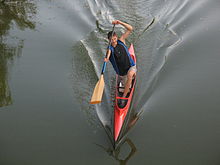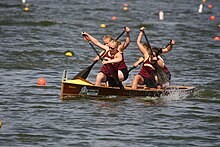
Canoe slalom is a competitive sport with the aim to navigate a decked canoe or kayak through a course of hanging downstream or upstream gates on river rapids in the fastest time possible. It is one of the two kayak and canoeing disciplines at the Summer Olympics, and is referred to by the International Olympic Committee (IOC) as Canoe/Kayak Slalom. The other Olympic canoeing discipline is canoe sprint. Wildwater canoeing is a non-Olympic paddlesport.

Adam Joseph van Koeverden is a Canadian sprint kayaker and politician. He is an Olympic gold medallist in the K-1 500m category (2004) and a two-time world champion in K-1 500 (2007) and K-1 1000 (2011), winning four Olympic and eight world championship medals. His home club is the Burloak Canoe Club in Oakville, Ontario.

Canoe sprint is a water sport in which athletes race in specially designed canoes or kayaks on calm water over a short distance. The sport is governed over by the International Canoe Federation and has been an Olympic sport since 1936.

Francis Amyot was a Canadian sprint canoeist who competed in the 1930s. He won Canada's only gold medal at the 1936 Summer Olympics.

The Rideau Canoe Club (RCC) is a canoe club located on the Rideau River in Ottawa, Ontario, Canada. The club is located at Mooney's Bay, where the Rideau Canal splits away from the river prior to joining up with the Ottawa River.
Angus Mortimer is a Canadian former sprint kayaker. He represented Canada at the 2008 Summer Olympics in Beijing, finishing ninth in the K-4 1000 m event. He won a gold medal in the 2007 Pan American Games K-1 1000m. He was banned from the sport after a 4-year investigation determined he engaged in grooming of children.
The Burloak Canoe Club is a flatwater canoe/kayak racing club located in Oakville, Ontario. It serves the communities of Burlington and Oakville and provides a variety of canoe-based activities for local residents focusing primarily on the two disciplines of sprint canoe and sprint kayak. Burloak Canoe Club is located on Navy Flats along the banks of Sixteen Mile Creek and boasts a sizable building that caters not only to sport but to special events as well.
The ICF Canoe Sprint World Championships are an international event in canoe racing, one of two Summer Olympic sport events organized by the International Canoe Federation. The World Championships have taken place every non-Olympic year since 1970 and officially included paracanoe events since 2010; since 2012, paracanoe-specific editions of this event have been held in Summer Paralympic years.
The 1979 ICF Canoe Sprint World Championships were held in Duisburg, West Germany.
The 2011 ICF Canoe Sprint World Championships was the thirty-ninth edition of the ICF Canoe Sprint World Championships, that took place between 17 and 21 August 2011 in Szeged, Hungary. The Southern Hungarian city welcomed the world event for the third time, having hosted the championship previously in 1998 and 2006. These championships were awarded initially to Vichy, France, however, the race course on the Allier proved to be inadequate to hold the competition and the French Canoe Federation withdraw from organizing the event, following that Szeged, the original host of the 2013 ICF Canoe Sprint World Championships, was moved up to 2011.
John Joseph Wood was a Canadian sprint canoeist who competed from the late 1960s to the later 1970s. Competing in three Summer Olympics, he won the silver medal in the C-1 500 m event at Montreal in 1976. The medal was Canada's first in the sport since 1952.

Canoe marathon is a paddling sport in which athletes paddle a kayak or canoe over a long distance to the finish line. The International Canoe Federation states the standard distances are at least 10 kilometres (6.2 mi) without an upper limit, while short distance races are between 3.4 kilometres (2.1 mi), and 10 kilometres (6.2 mi). Many events are raced down sections of river, including currents or portages around obstacles. Some events attract thousands of competitors and are staged over several days.

Mark de Jonge is a Canadian male sprint canoeist, primarily specializing the 200 m kayak event. De Jonge won a bronze medal in the K-1 200 m at the 2012 Summer Olympics in London. He is the two time reigning world champion in same event having also won a silver medal at the ICF Canoe Sprint World Championships in 2013. He is also the current Pan American champion in the 200 having won gold in Toronto at the 2015 Pan American Games in Toronto, where he also won an additional bronze, and a silver and bronze at previous editions of the Pan Am Games. He was named the Air Canada Athlete of the Year in 2015 for Canada.
Renn Crichlow is a Canadian sprint kayaker who competed from the late 1980s to the late 1990s. He won a complete set of medals at the ICF Canoe Sprint World Championships with gold, a silver, and a bronze.
The ICF Canoe Slalom World Championships are an international event in canoeing organized by the International Canoe Federation. The World Championships have taken place every year in non-Summer Olympic years since 2002. From 1949 to 1999, they had taken place in odd-numbered years. The 2001 championships were scheduled to take place in Ducktown, Tennessee from 20 to 23 September, but were canceled in the wake of the September 11 attacks.
John Howard Edwards is a Canadian sprint canoer who competed in the mid-1970s. He was a member of the National Team at the 1972 Summer Olympics in Munich. At the 1976 Summer Olympics in Montreal, he was eliminated in the repechages of the C-2 1000 m event while finishing ninth in the C-1 1000 m event.

Canoeing – recreational boating activity or paddle sport in which you kneel or sit facing forward in an open or closed-decked canoe, and propel yourself with a single-bladed paddle, under your own power.

Paracanoe is canoeing for athletes with a range of physical disabilities. The Paralympic version of the sport is governed by the International Canoe Federation (ICF), and a va'a-specific variant is governed by the International Va'a Federation (IVF).
The 2018 ICF Canoe Sprint World Championships, the 44th edition of the World Championships, were held in Montemor-o-Velho, Portugal, from 22 to 26 August 2018.
The 2019 ICF Canoe Sprint World Championships, the 45th edition of the World Championships, were held in Szeged, Hungary from 21 to 25 August 2019.











